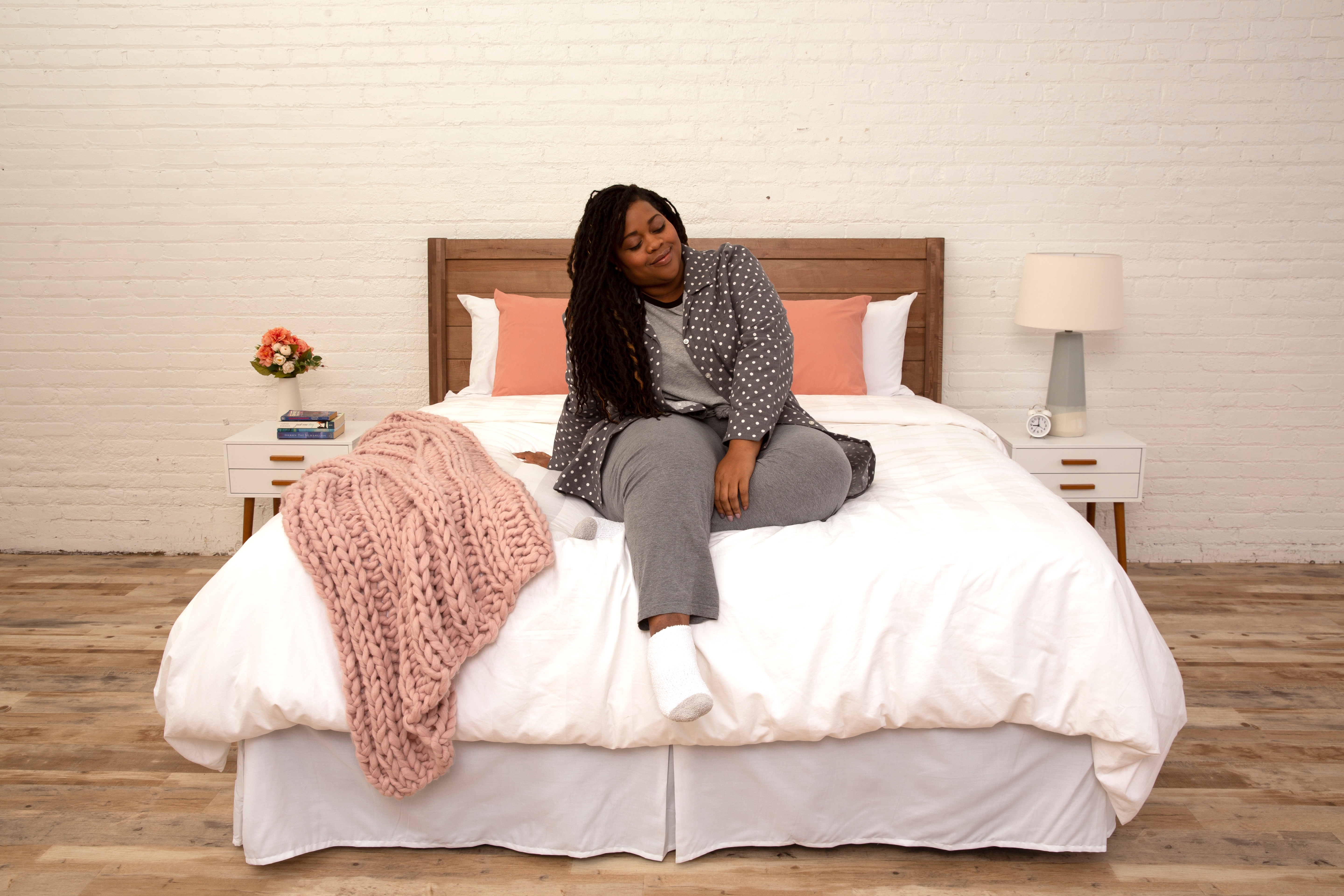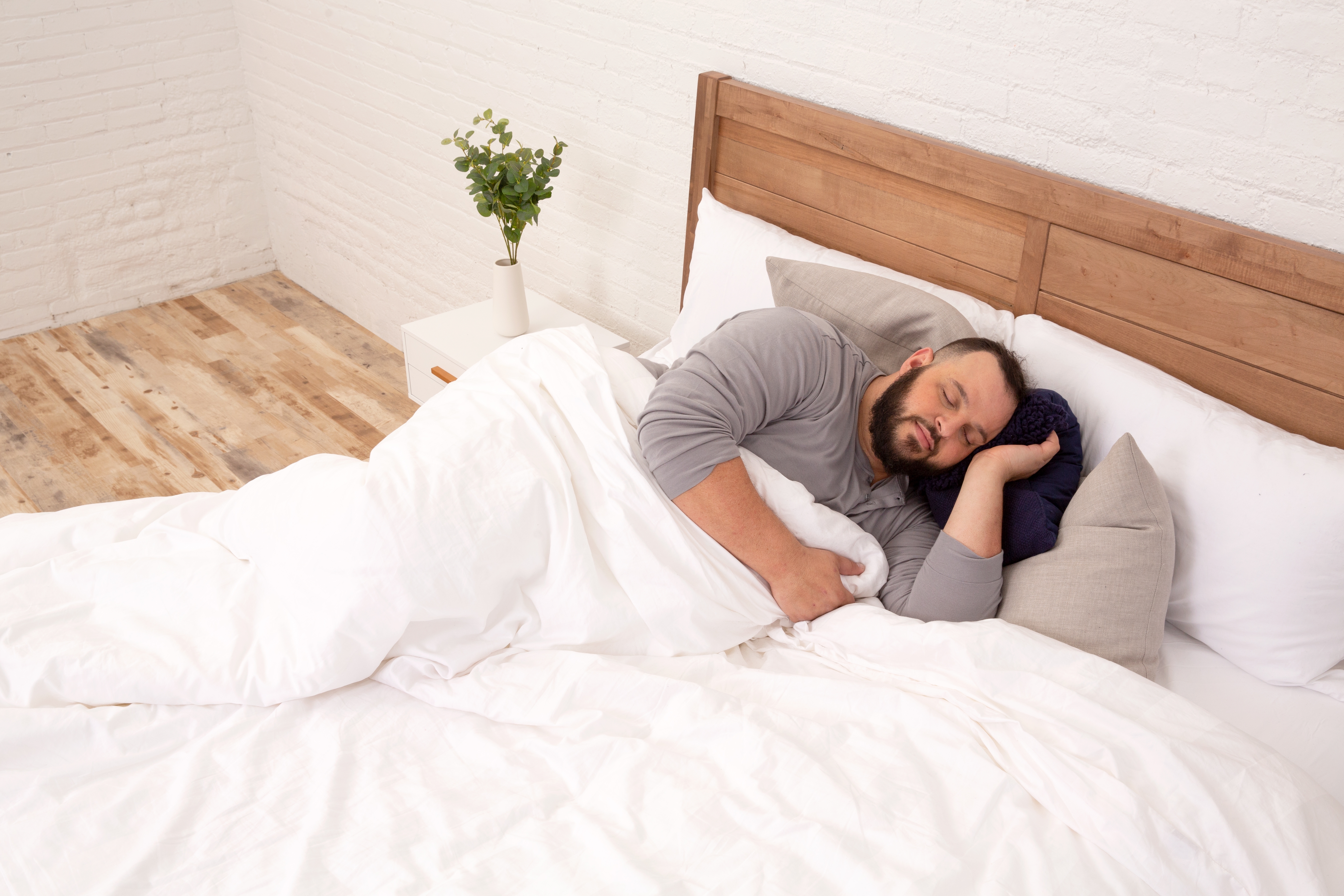When you search “best mattresses for sleep apnea” on Google, ideally, you'd find unbiased, third-party sources with scientific backing recommending the best options. Instead, you get a slew of mattress companies touting their products with unverified claims and conflicting information. Unfortunately, there’s a lack of credible scientific studies linking specific mattresses to improved sleep apnea symptoms. Many companies exploit this gap, making dubious claims about their products. At Big Fig, we’re dedicated to serving the plus-sized community, which is more at risk for sleep apnea than any other. We avoid false promises and instead provide honest, proven information about mattress benefits.
What is sleep apnea?
In simple terms, sleep apnea is a condition where breathing repeatedly stops and starts during sleep, disrupting the sleep cycle and reducing sleep quality. This leads to lower oxygen levels, increased heart rate, higher blood pressure, and over time, can cause a stiffer heart muscle. This temporary side effect becomes a serious issue when you start to experience apnea frequently. “Frequently,” according to the Cleveland Clinic, can mean 30 times or more per hour, but that’s not to say negative side effects can’t take place with less frequent apnea. If untreated, sleep apnea can result in serious long-term health issues such as high blood pressure, heart disease, diabetes, and depression. In the short term, it also increases the risk of accidents due to fatigue.
What Causes Sleep Apnea?
- Enlarged tonsils or adenoids: These can block the airway, particularly in children.
- Certain physical characteristics: A thick neck, a narrow throat, or a recessed chin can contribute to airway obstruction.
- Aging: Muscle tone decreases with age, which can lead to airway collapse during sleep.
- Alcohol and sedatives: These can relax the throat muscles, increasing the risk of airway obstruction.
- Heart disorders: Conditions like congestive heart failure can affect the brain's ability to regulate breathing.
- Family history: Genetics can play a role in the development of sleep apnea.
- Smoking: Smoking can increase inflammation and fluid retention in the upper airway.
- Nasal congestion: Chronic nasal congestion can contribute to airway obstruction.
Types of Sleep Apnea
Sleep apnea is diagnosed with sleep studies, in which doctors measure the frequency and duration of apneas in snoozing patients and track oxygen levels.
There are three types of sleep apnea:
Obstructive
Takes place when throat muscles restrict breathing. This is the most common type of sleep apnea
Central
Occurs when the brain does not send proper signals to breathe.
Complex
Complex, which is a combination of the first two.
All three types of sleep apnea have common symptoms, including:
- Abnormal breathing
- Daytime fatigue
- Headaches
- Irritability
- “Fuzzy” thoughts or trouble focusing
Obstructive sleep apnea, specifically, is also characterized by snoring, sore throat and frequent trips to the bathroom during the night. Many people associate snoring with sleep apnea, but snoring is just the most common symptom of OSA. Not everyone who snores has OSA and snoring is not a common symptom of central sleep apnea (CSA).
How common is sleep apnea?
Unfortunately, sleep apnea is an extremely common sleep disorder. With approximately 18 million people receiving a sleep apnea diagnosis this year, it’s about as common in Americans as Type 2 diabetes. Even more dismaying, many sleep apnea patients remain undiagnosed due to lack of education and knowledge of sleep apnea in the healthcare field.
With the data available, we can estimate that OSA affects between 2% and 9% of adults in the U.S. Other studies estimate that 1 in every 4 men and 1 in every 10 women has sleep apnea.
This does not count the number of children suffering from sleep apnea. In fact, many people aren’t even aware children can suffer from sleep apnea. While people over 50 and heavier sleepers are more likely to experience it, anyone of any gender or age can be diagnosed with sleep apnea.
How to Cure Sleep Apnea
Curing sleep apnea depends on its type, as well as individual health factors. Surgery is only reserved for the most severe cases. It’s important to consult with a healthcare provider or a sleep specialist to determine the most appropriate treatment based on individual needs and the specific characteristics of your sleep apnea. Here’s an overview of common treatments and management strategies:
Lifestyle Changes
- Weight loss
- Changing sleeping position
- Quitting smoking and limiting alcohol consumption
Continuous Airway Pressure Devices
- CPAP Machine: This is the most common and effective treatment for OSA. The CPAP machine delivers a continuous stream of air through a mask that keeps the airway open during sleep.
Positive Airway Pressure Devices
- BiPAP: Bilevel Positive Airway Pressure devices are similar to CPAP but provide two levels of pressure—one for inhalation and a lower one for exhalation.
- APAP: Auto-titrating Positive Airway Pressure devices adjust the pressure automatically based on detected airflow changes.
How to choose the best mattresses for sleep apnea
Now that you understand the risk sleep apnea poses and the impact it has on the lives of millions of Americans, we can ask the question. Is there a mattress best suited for patients with sleep apnea?
Choosing the right mattress can be an important factor in managing sleep apnea. While a mattress alone won't cure sleep apnea, it can contribute to better sleep quality and comfort, which may help alleviate some symptoms.
As we said, we aren’t making any false claims or sales pitches. Instead, we’re sticking to the facts and helping you understand what the mattress market knows—and what it doesn’t know. Here’s what we can confidently say.
Sleep apnea and Mattress Firmness
A mattress alone cannot cure sleep apnea, but it may help alleviate symptoms. Studies and sleep specialist advice suggest that the right mattress and sleep position can offer relief. A firmer mattress tends to keep sleepers aligned and prevents sinking, which can help keep airways open. Softer mattresses, on the other hand, may deteriorate quickly and cause misalignment that can worsen symptoms.
Side sleepers, especially those using a CPAP machine, often benefit from a mattress that offers both support and comfort to align the spine and relieve pressure. Similarly, stomach sleepers usually prefer firmer mattresses, which can also help reduce sleep apnea symptoms. Overall, while individual needs vary, choosing the right mattress can contribute to symptom relief.
Sleep apnea and Mattress Materials
When we say “firm” and “soft,” those terms are utterly subjective. In our experience with the Big Fig, for example, we’ve had 100-lb. sleepers tell us the Big Fig is like sleeping on a cloud, and we’ve had 400-lb. sleepers return their purchase, saying it feels like a rock!
Memory foam, often marketed as a soft solution for side sleepers, can cause issues for heavier individuals, including heat retention and a "trapped" feeling. Additionally, lower-quality memory foam can sag over time, affecting support. Hybrid mattresses, which blend support and comfort, can offer better body alignment and airway openness for side sleepers. Ultimately, exploring different materials and firmness levels might lead to improved sleep quality.
Sleep apnea and Bed Angle
If you’re accustomed to back sleeping, switching positions to alleviate sleep apnea can seem daunting. However, an adjustable bed that raises your head can help reduce symptoms and snoring. For those who prefer staying on their back, this adjustment can improve airway openness. Alternatively, an extra wedge pillow might also be effective.
Sleep Big, Live Bigger
There’s no one-size-fits-all solution or magic mattress for sleep apnea; it requires medical advice first and foremost. Alongside following your doctor’s recommendations, experimenting with sleep positions, wedge pillows, room temperature, and other controllable factors may help before investing in a new mattress. Finding what works for you is crucial to achieving restful sleep. Remember, prioritizing your health and well-being is more important than any sales pitch or product claim.
The Big Fig is the first mattress built specifically to meet the needs of bigger-figured sleepers. We’re exploring sleep disorders we see frequently within our customer base. Get a hold of your sleep apnea symptoms with a Big Fig Mattress!






